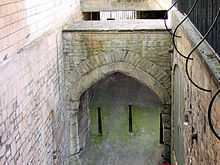Bath city walls
| Bath city walls | |
|---|---|
| Bath, Somerset, Somerset | |
|
Remains of Bath's city walls | |
 Bath city walls | |
| Coordinates | grid reference ST751648 |
| Type | City wall |
Bath's city walls are a sequence of defensive structures built around the city of Bath in England.
History
Bath's first walls were built by the Romans.[1] The Anglo-Saxons constructed a fortified burh at Bath, utilising the existing city walls, maintaining the city as a centre of regional power.[2] Bath, located along the northern edge of the kingdom of Wessex, would have also guarded against any attack from neighbouring Mercia, held by the Danes.[3]

The height of the walls was increased on the orders of King Stephen during The Anarchy.[4] Bath's medieval walls included four gates. The North and South Gates were both decorated with a number of statues, including the legendary King Bladud and Edward III.[5] The two gates were linked to local churches, St Mary's and St James' respectively.[6] The North and South Gates were demolished in 1755.[7]
During the Second World War bomb damage to Bath revealed parts of the city walls previously lost from view behind other buildings.[8] The remaining wall circuit is now protected as a Grade II listed building and a scheduled monument.[9] Only part of one of Bath's medieval gates still survives, East Gate, located near Pulteney Bridge in the city.[10]
In 1980 a timber barricade was found close to the north city wall. This may have been erected in the Saxon era to allow repair of the stonework.[11][12] A sword from the late tenth or early 11th century was also found, which may date from a skirmish in 1013.[13]

The route of the walls is as follows:
Medieval Walls Borough walls - just by junction with Trim Street. The circuit presumably follows the line of the late Roman Walls — a piece of which was found in 2013 in Burton St.[14]

The wall circuit can be identified on any street map but it is as follows:
Borough walls — east to Bridge Street. Turns south just before Pulteney Bridge (The East Gate was here and some remains here to be seen).[16] It the goes south through the east end of the Butter Market, east of the Orange Grove, an angle at Terrace Walk. It runs south west just to and parallel to Orchard Street. It turns west at junction with Henry Street. Southgate at junction of Southgate Street and Stall Street.
Wall heading west along south side of Lower Borough Walls, beginning to head north along Westgate Buildings, wall to the west of the Road. Westgate at end of Westgate Street. The wall continues north up Upper Westgate Buildings and into Saw Close, below the theatre and turns east at the Junction of Borough Walls.
See also
References
- ↑ Creighton and Higham, p.60.
- ↑ Creighton and Higham, p.36.
- ↑ Creighton and Higham, p.57.
- ↑ Davenport pages 91-92
- ↑ Creighton and Higham, pp.141-142.
- ↑ Creighton and Higham, p.177.
- ↑ Creighton and Higham, p.141.
- ↑ Creighton and Higham, p.246.
- ↑ Bath City Wall, Gatehouse website, accessed 8 October 2011.
- ↑ Creighton and Higham, p.254.
- ↑ Manco, Jean. "Alfred's Borough". Bath Past. Retrieved 10 October 2011.
- ↑ O'Leary, T.J. "Excavations at Upper Borough Walls, Bath, I 980" (PDF). Archaeology Data Service. Retrieved 2009-10-24.
- ↑ Davenport pages 62-63
- ↑ "Sewer workers in Bath reveal part of Roman city's walls". BBC. Retrieved 27 September 2013.
- ↑ Davenport, Peter (2002). Medieval Bath Uncovered. Stroud: Tempus. ISBN 0-7524-1965-X.
- ↑ Historic England. "East Gate (1394942)". National Heritage List for England. Retrieved 4 April 2015.
Bibliography
- Creighton, Oliver Hamilton and Robert Higham. (2005) Medieval Town Walls: an Archaeology and Social History of Urban Defence. Stroud, UK: Tempus. ISBN 978-0-7524-1445-4.
- Davenport, Peter (2002). Medieval Bath Uncovered. Stroud: Tempus. pp. 62–63. ISBN 0-7524-1965-X.
